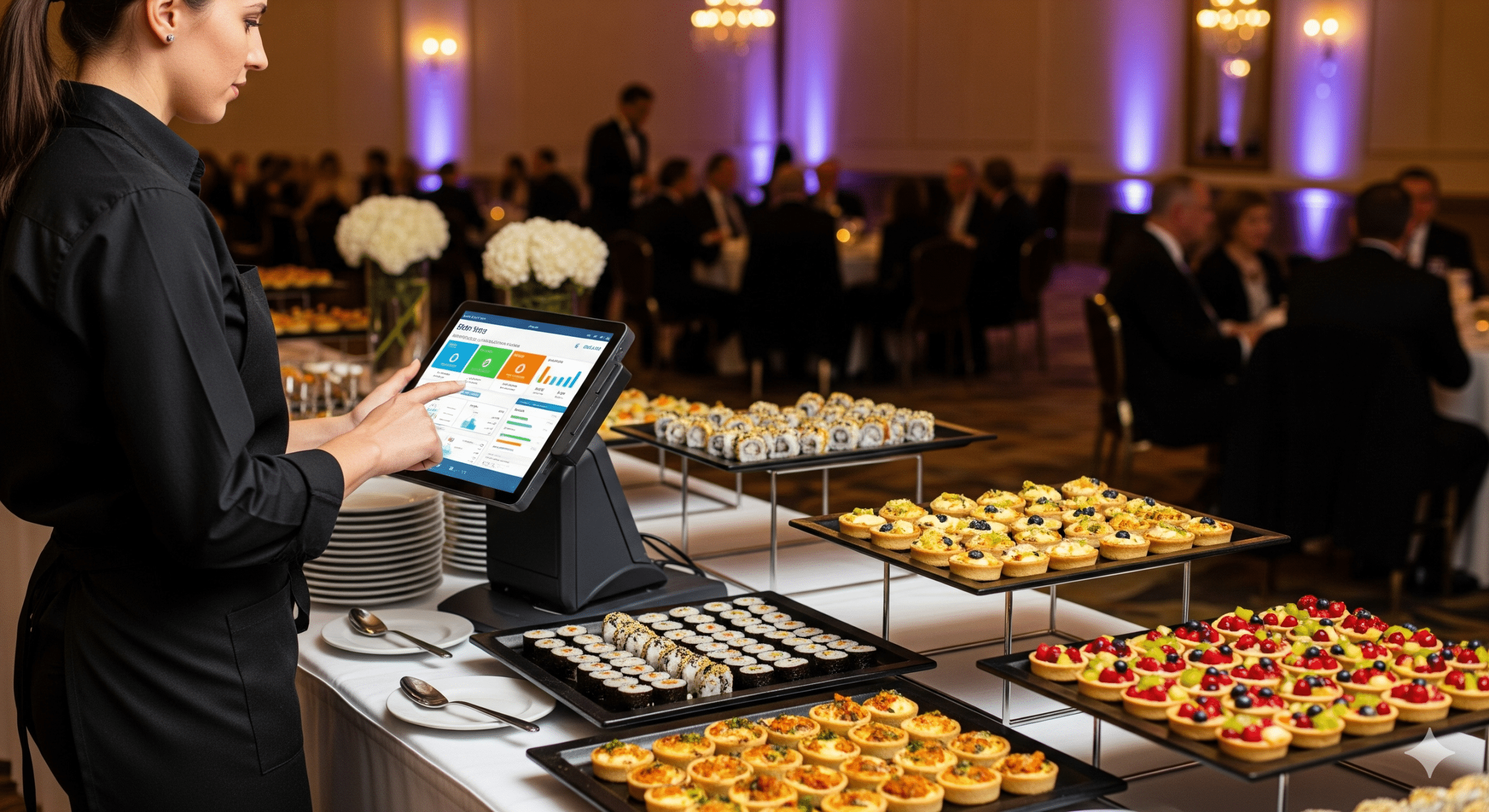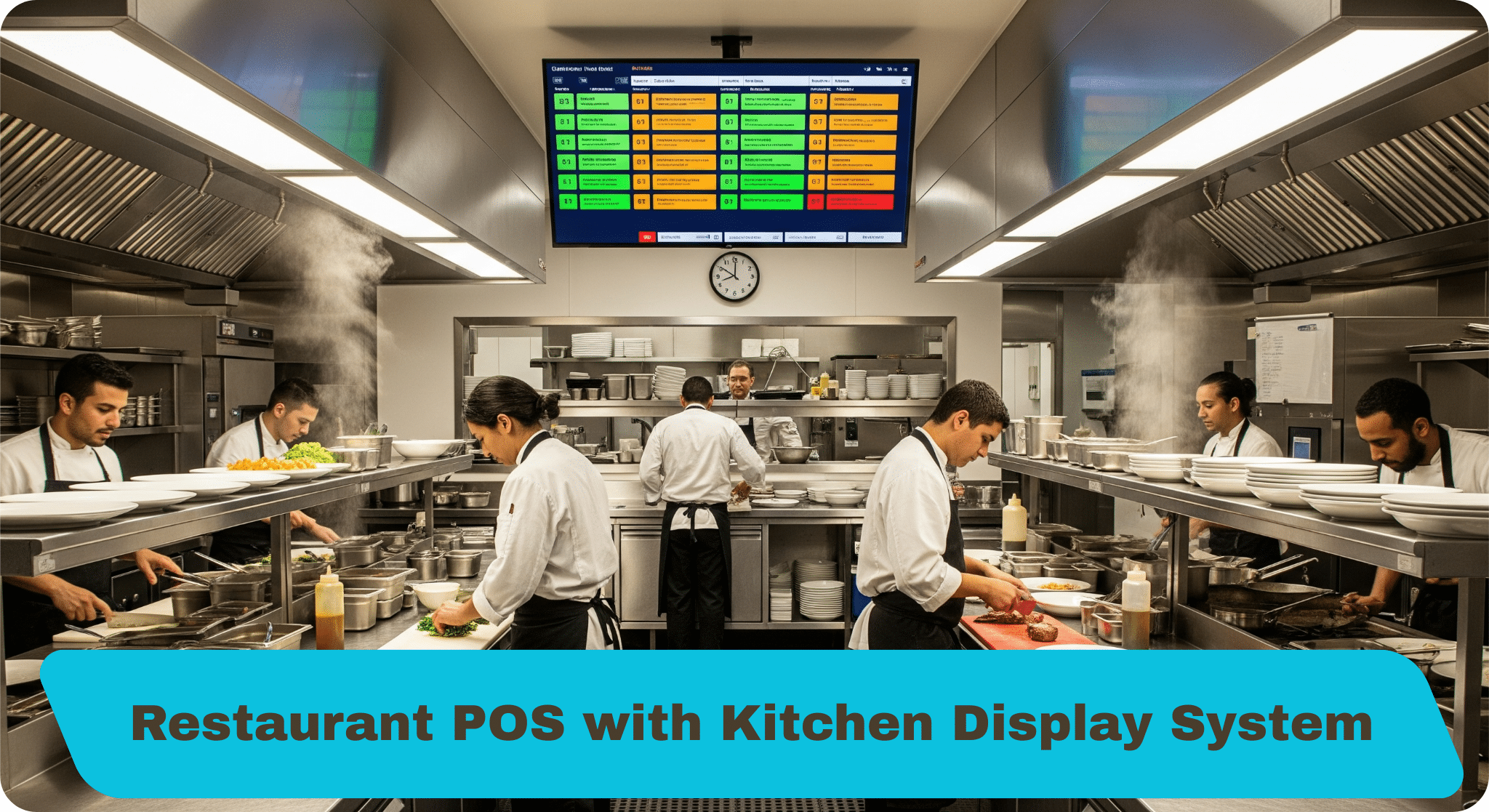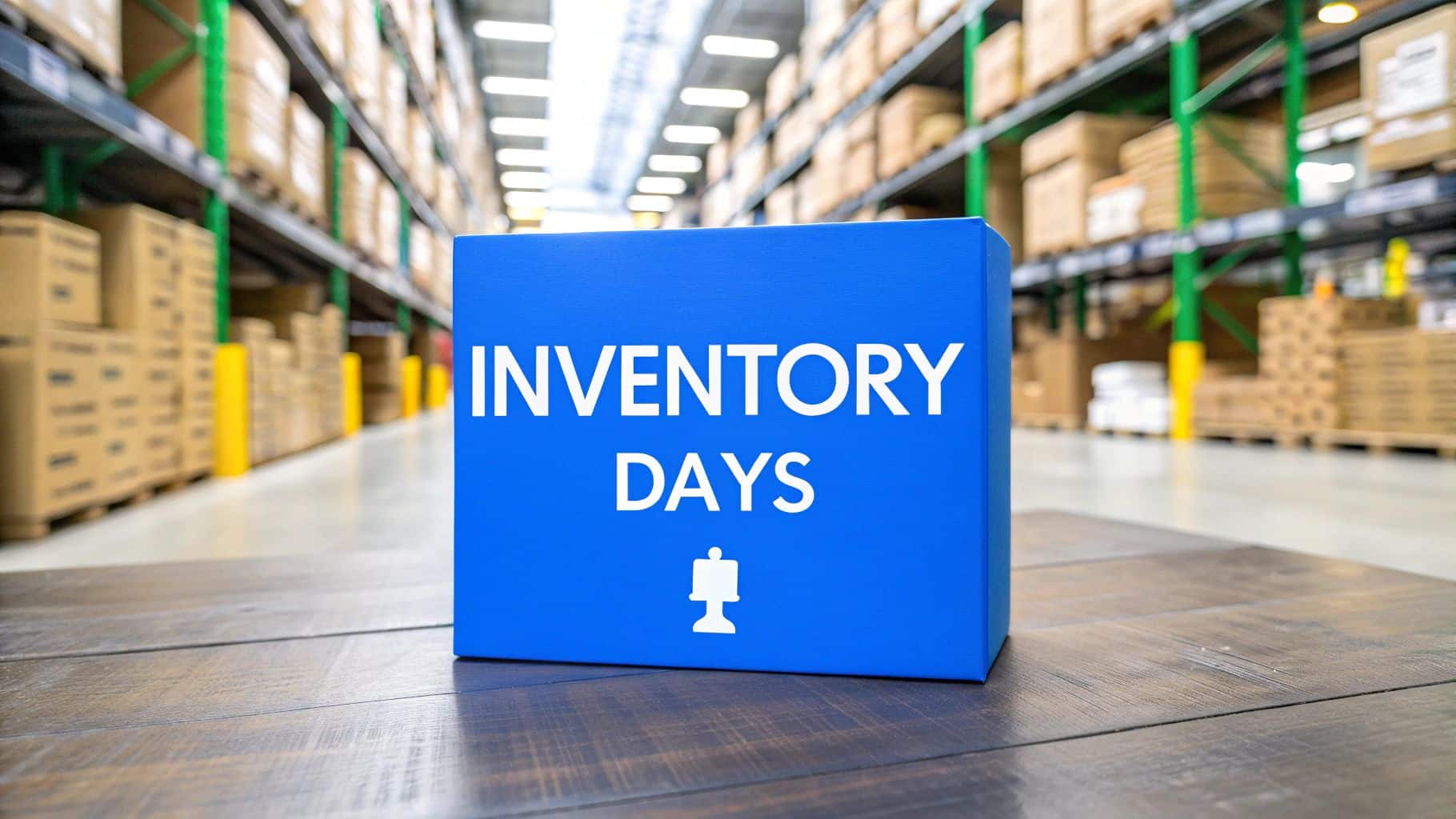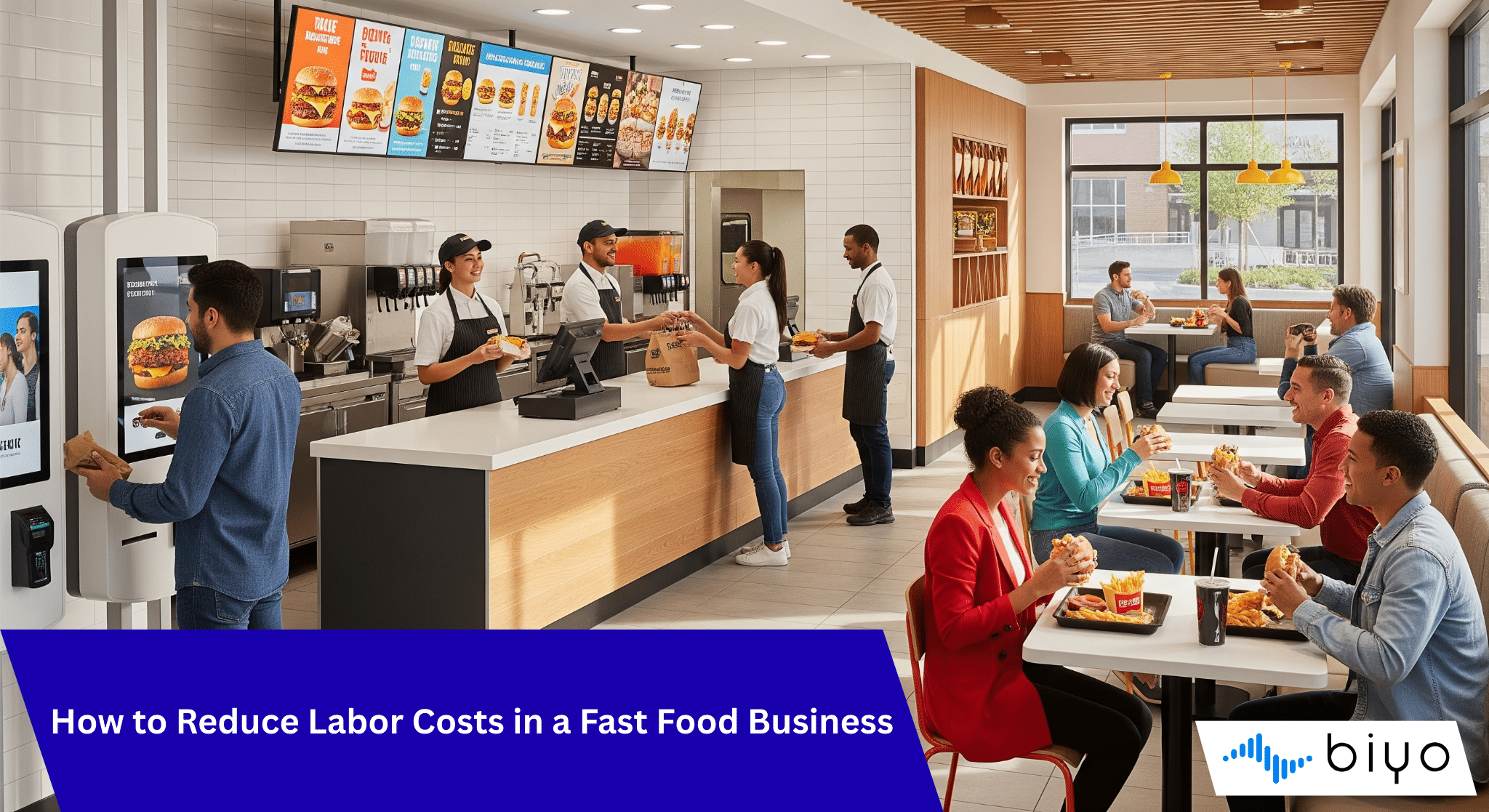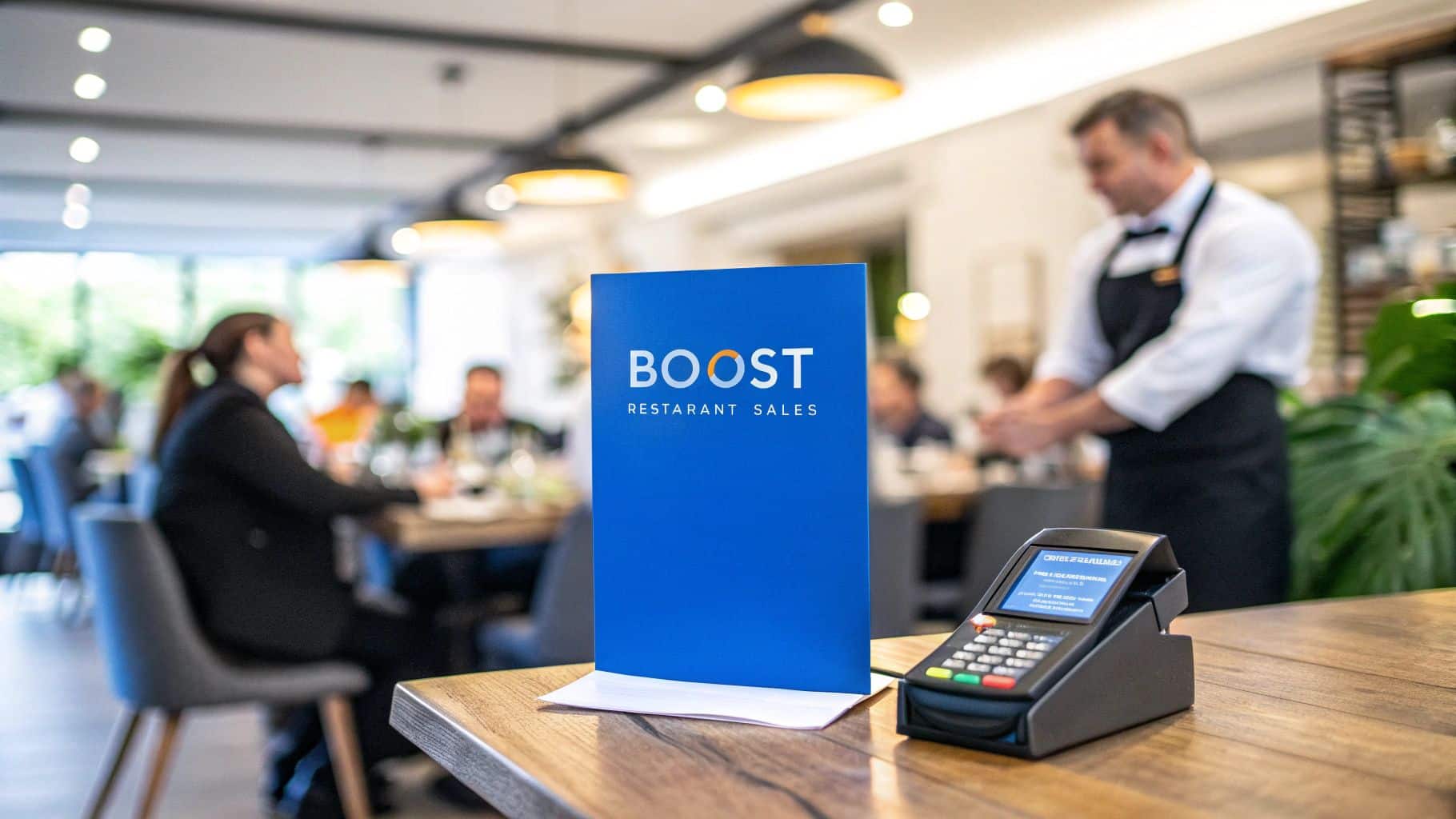Running a catering company involves juggling multiple moving parts—from managing event schedules to coordinating staff, handling client communication, and ensuring flawless delivery. The process becomes overwhelming without the right tools. This is where the benefits of a catering POS system truly shine. A catering POS system simplifies daily operations, streamlines communication, and provides the structure that catering businesses need to grow efficiently. By integrating technology into catering operations, businesses can not only increase efficiency but also achieve measurable revenue growth.
Table of Contents
- Streamlined Ordering and Menu Management
- Staff Scheduling and Guest Management
- Payment Processing and Billing Automation
- Real-Time Reporting and Business Insights
- Increased Efficiency and Client Satisfaction
Streamlined Ordering and Menu Management
A successful catering service thrives on smooth ordering and menu organization. Clients expect their preferences to be honored and their events to run without a hitch. A catering POS system makes this possible by consolidating orders, supporting menu customization, and keeping the kitchen aligned with event requirements.
Effortless Streamlined Ordering
One of the core benefits of a catering POS system is streamlined ordering. Clients can place their requests directly into the system, reducing the chance of miscommunication. Orders are captured in real time, preventing manual errors that often arise from phone calls or handwritten notes. For caterers, this eliminates the guesswork and ensures every detail is documented.
When orders flow seamlessly from the client to the kitchen, teams can focus on quality execution. The system also allows caterers to accept multiple orders simultaneously without overwhelming staff. This capacity is especially valuable during busy seasons when event requests peak. By maintaining order clarity, businesses uphold their reputation for professionalism.
Another advantage is quick adjustments. If a client requests last-minute changes, the POS system updates the kitchen instantly. Whether it’s a dietary restriction or portion adjustment, the order reflects the modifications in real time. This adaptability improves customer satisfaction and builds long-term trust.
For example, if a corporate event suddenly adds 30 attendees, the POS system can immediately adjust serving portions and inventory requirements. Without such technology, staff would scramble to reorganize, leading to stress and potential mistakes. The automation ensures smooth transitions even in high-pressure scenarios.
Menu Customization Made Simple
Catering often involves tailoring menus to suit different events—be it a corporate luncheon, a wedding reception, or a birthday party. A catering POS system enables easy menu customization with clear item breakdowns and pricing transparency. Caterers can create preset packages or à la carte menus, giving clients the freedom to design their ideal event menu.
This flexibility reduces the need for lengthy back-and-forth communication. Clients can see available options in real time, including allergen details, portion sizes, and pricing tiers. The streamlined process not only boosts efficiency but also enhances the customer experience. People feel more confident when they have control over their menu choices.
For the kitchen staff, customized menus flow directly into kitchen display integration. The team can prioritize dishes, schedule preparation, and minimize waste. The result is a more organized kitchen with reduced errors and faster turnaround times for large-scale events.
Imagine a wedding where half the guests request vegan meals. With menu customization tools, the caterer can instantly adjust ingredient requirements, communicate changes to the kitchen, and provide accurate cost projections. This ensures a seamless event where every guest feels cared for.
Kitchen Display Integration for Accuracy
Kitchen display integration ensures orders move seamlessly from front-end ordering to back-of-house execution. Unlike paper tickets, digital displays reduce confusion, clarify priorities, and synchronize tasks across multiple kitchen stations. This is especially useful when handling large banquets or multi-course meals.
With direct POS-to-kitchen communication, staff instantly see any changes made to orders or menus. This minimizes errors that could affect event success. By aligning the front and back of operations, catering businesses build consistency in service delivery. Such accuracy is invaluable in high-stakes events like weddings, where even minor mistakes can disrupt the flow.
In addition, digital displays improve efficiency by automatically prioritizing time-sensitive dishes. This helps teams deliver meals at the right temperature and quality, ensuring guests enjoy their dining experience. In the long run, smoother kitchen workflows translate to better client reviews and stronger brand reputation.
Consider a banquet where multiple courses must arrive at tables simultaneously. Kitchen display integration ensures every chef knows their timing and role. This orchestration prevents delays and guarantees an elevated dining experience that reflects positively on the caterer.
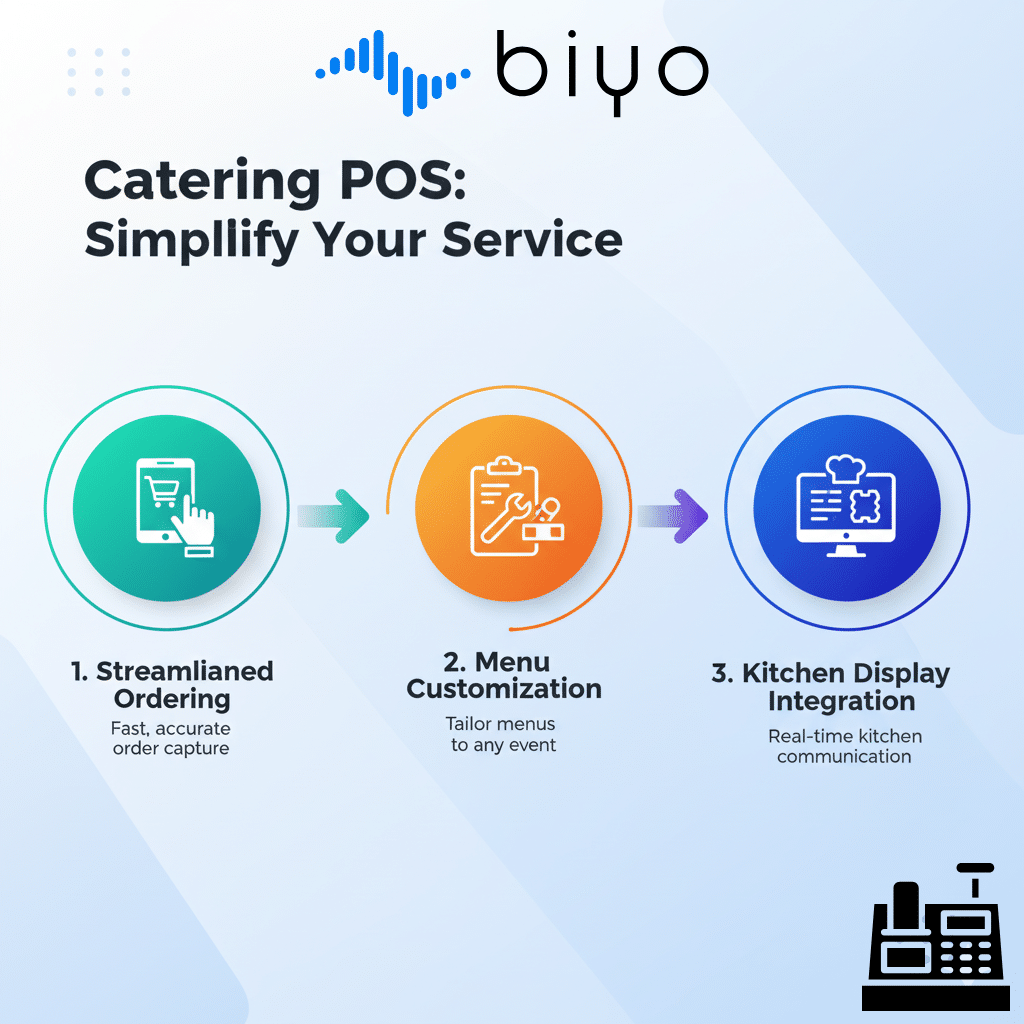
Staff Scheduling and Guest Management
Behind every catering event is a team of professionals working in harmony. Managing these staff members, alongside tracking guest preferences and requirements, can be daunting. A catering POS system simplifies these responsibilities with tools designed for staff scheduling and guest management.
Smart Staff Scheduling
Catering events require precise staffing. Overstaffing increases expenses, while understaffing leads to poor service. One of the key benefits of a catering POS system is automated staff scheduling. Managers can assign shifts based on event size, complexity, and staff availability. This ensures the right number of employees are present at the right time.
The system also tracks staff hours, reducing payroll errors and disputes. Employees can access their schedules through mobile access, minimizing miscommunication. This improves staff morale and accountability, as everyone has a clear understanding of their role.
During peak seasons, the system makes scheduling adjustments fast and efficient. By predicting staffing needs based on past events, it eliminates guesswork. This proactive approach allows caterers to meet demand without overspending on labor.
For instance, if past data shows that large wedding receptions require 15 servers, the system automatically suggests staffing at that level. This eliminates the stress of last-minute adjustments and ensures events run smoothly from start to finish.
Efficient Guest Management
Guests are at the heart of every catering event. A POS system centralizes guest management by keeping track of dietary needs, seating arrangements, and attendance. This ensures no guest feels overlooked. For example, vegetarian or gluten-free requests are flagged for the kitchen, ensuring personalized service.
Organized guest lists also make communication easier. Whether confirming RSVPs or sending event reminders, caterers can manage everything through the system. This saves time while strengthening the relationship with clients and their guests. Happy guests often translate into repeat bookings and referrals.
Guest management tools also support seating charts and event layouts. By aligning staff assignments with guest arrangements, caterers guarantee smooth service delivery. This reduces confusion and helps events run seamlessly from start to finish.
Picture a corporate gala where VIP guests have special dining needs. With centralized guest management, the system ensures staff know exactly where these guests are seated and what meals they require. This proactive service makes clients feel valued and respected.
Event Scheduling and Coordination
A successful catering event hinges on precise scheduling and coordination. The POS system integrates event calendars with staff shifts, guest requirements, and kitchen tasks. This holistic view ensures every detail aligns with the client’s expectations. As a result, events run more smoothly and on time.
Event scheduling tools also provide reminders for key milestones—such as payment deadlines, contract signings, and delivery times. This prevents oversights that could harm the business. Clients appreciate the proactive approach, which reassures them that their event is in capable hands.
By coordinating all elements through one platform, caterers minimize the risk of errors and build stronger client trust. The outcome is more efficient operations and higher satisfaction rates.
For example, a catering manager can use the POS system to align kitchen prep times with delivery schedules. This ensures food is prepared, packed, and delivered at the exact right moment, eliminating stress and increasing client confidence.
Payment Processing and Billing Automation
Finances are at the core of catering operations. From processing deposits to sending invoices, accuracy is non-negotiable. A catering POS system simplifies financial management with payment processing and billing automation tools.
Secure Payment Processing
Clients expect secure, flexible payment options. A catering POS system accepts multiple payment methods—including credit cards, mobile wallets, and online transfers. This flexibility enhances convenience for clients, while ensuring funds are received quickly and securely. Secure payment processing also reduces the risks of fraud and chargebacks.
Clients gain peace of mind knowing their transactions are protected. For caterers, faster payments improve cash flow, allowing businesses to invest in supplies and staff. By integrating payments into the POS system, errors from manual entry are eliminated, boosting financial accuracy.
Flexible payment options also help caterers accommodate international clients or corporate events. This adaptability broadens the business’s reach and strengthens its professional image.
Consider a catering business that serves international conferences. By supporting global payment methods, the POS system helps avoid delays, ensuring smooth financial transactions across borders.
Automated Invoice Generation
Sending invoices manually can be time-consuming and error-prone. A catering POS system automates invoice generation, ensuring accuracy in billing. Clients receive itemized breakdowns of services, making charges transparent and easy to understand. This builds trust and reduces disputes over payments.
Automated invoices can also be scheduled, ensuring clients receive reminders on time. This reduces delays in payment collection and supports consistent cash flow. For recurring clients, the system can generate recurring invoices, saving time for both parties.
With billing automation, caterers can focus less on administrative tasks and more on delivering exceptional service. The streamlined process improves client satisfaction while strengthening financial stability.
Imagine handling dozens of weddings in a single season. With automated invoicing, caterers avoid late payments and eliminate disputes, keeping revenue predictable and operations stress-free.
Expense Tracking and Contract Management
Catering involves multiple expenses—from food costs to staff wages and venue rentals. A POS system tracks these expenses in real time, allowing managers to monitor budgets closely. This transparency helps caterers identify cost-saving opportunities without compromising service quality.
Contract management tools built into the POS system also streamline client agreements. Contracts are stored digitally, making them easy to access and update. Automated reminders ensure no deadlines are missed, reducing the risk of legal or financial issues.
Together, expense tracking and contract management give caterers a clear financial picture. This empowers them to make data-driven decisions, maximize profits, and maintain long-term client trust.
For example, when planning a multi-day corporate retreat, expense tracking ensures costs remain within budget. Simultaneously, contract automation keeps agreements consistent, protecting both caterer and client from misunderstandings.
Real-Time Reporting and Business Insights
Data is a powerful tool for growth. A catering POS system provides real-time reporting and valuable business insights that help managers make informed decisions. From sales trends to staff performance, these insights support strategic planning.
Comprehensive Real-Time Reporting
One of the strongest benefits of a catering POS system is the ability to generate reports instantly. Managers can track sales, monitor expenses, and analyze event performance. This real-time data eliminates the delays associated with manual reporting and empowers caterers to respond quickly to challenges.
Real-time reporting also helps identify top-performing services and menu items. Caterers can highlight popular offerings in marketing campaigns, boosting sales. At the same time, underperforming items can be adjusted or removed to optimize menus and reduce waste.
With accurate data, businesses gain a competitive edge. Decision-making becomes more strategic, leading to consistent improvements in efficiency and profitability.
For instance, if data shows that seasonal fruit platters consistently outsell other appetizers, caterers can stock accordingly. This prevents waste and increases profit margins without compromising service quality.
Actionable Business Insights
A POS system provides actionable insights by analyzing trends across multiple data points. For instance, it may reveal seasonal spikes in certain menu items or highlight which services generate the most revenue. These insights allow caterers to refine their strategies and allocate resources wisely.
Business insights also support staffing decisions. By understanding peak times, managers can optimize staff scheduling and reduce unnecessary labor costs. This balance increases profitability while maintaining excellent service standards.
In addition, insights into client behavior help businesses improve customer communication. By recognizing repeat clients or preferred services, caterers can offer personalized promotions, enhancing loyalty and retention rates.
Imagine a caterer noticing that corporate clients consistently book holiday luncheons in December. Insights from the POS system could lead to targeted holiday promotions, boosting seasonal revenue significantly.
Client Database and Customer Communication
A catering POS system builds a centralized client database. This repository includes contact information, event history, and preferences, making client communication more effective. Businesses can use this database to send targeted updates, event reminders, or promotional offers.
Effective communication fosters stronger relationships and encourages repeat bookings. Clients feel valued when businesses remember their past events and anticipate their needs. This personalized approach enhances customer satisfaction and strengthens brand loyalty.
The database also simplifies contract renewals and billing follow-ups. By maintaining a record of client interactions, caterers can provide consistent service across multiple events. This professionalism helps businesses stand out in a competitive market.
For instance, sending a personalized thank-you message after a successful wedding can encourage clients to recommend the caterer. These small gestures, supported by database tools, build long-term loyalty.
Increased Efficiency and Client Satisfaction
Efficiency is the foundation of success in catering. By reducing manual tasks, minimizing errors, and improving coordination, a catering POS system ensures that businesses operate at peak performance. This, in turn, drives higher client satisfaction and revenue growth.
Improved Delivery Coordination
Timely delivery is critical in catering. A POS system supports delivery coordination by tracking routes, assigning drivers, and providing real-time updates. Clients appreciate being informed about delivery timelines, and staff gain clarity on their responsibilities. This eliminates confusion and reduces delays.
For large events, the system also manages multiple deliveries to different venues. Coordinating these tasks manually would be overwhelming. With automated tracking, caterers can handle complex logistics smoothly, boosting their reputation for reliability.
Delivery coordination tools also allow caterers to calculate costs more accurately. By tracking mileage and time, they can adjust fees fairly and transparently. This increases profitability while maintaining client trust.
Imagine a city-wide food festival requiring deliveries at multiple locations. Without a POS system, logistics could collapse under pressure. With delivery coordination tools, everything arrives fresh, on time, and at the right venue.
Effective Inventory Control
Inventory management is vital for reducing waste and ensuring adequate supply. A catering POS system provides real-time updates on stock levels, preventing shortages or overstocking. This balance keeps costs under control and supports smooth event execution.
With inventory control, caterers can also forecast demand. By analyzing past events, the system predicts how much food and supplies are needed for future events. This prevents last-minute shortages and ensures clients receive the quality they expect.
Automated inventory alerts notify managers when stock runs low. This proactive approach helps avoid emergencies, allowing businesses to operate with confidence and consistency.
For example, if data shows that pasta dishes are frequently ordered at conferences, the system ensures enough ingredients are stocked ahead of time. This foresight saves money and maintains service standards.
Driving Revenue Growth
When businesses operate efficiently, revenue growth follows. A catering POS system reduces operational costs by eliminating errors and saving time. At the same time, it increases sales opportunities through upselling options, targeted promotions, and accurate reporting.
Revenue growth also stems from improved client satisfaction. Happy clients are more likely to rebook services and recommend the caterer to others. This organic growth builds a loyal customer base and strengthens the brand’s market position.
With streamlined operations, reliable reporting, and strong client relationships, caterers are well-positioned to scale their businesses sustainably. The POS system serves as the foundation for this long-term success.
Consider a small catering company that adopts a POS system. Within months, the improved efficiency reduces waste by 20% and increases repeat bookings. The system’s role in driving measurable growth proves its value as a long-term investment.
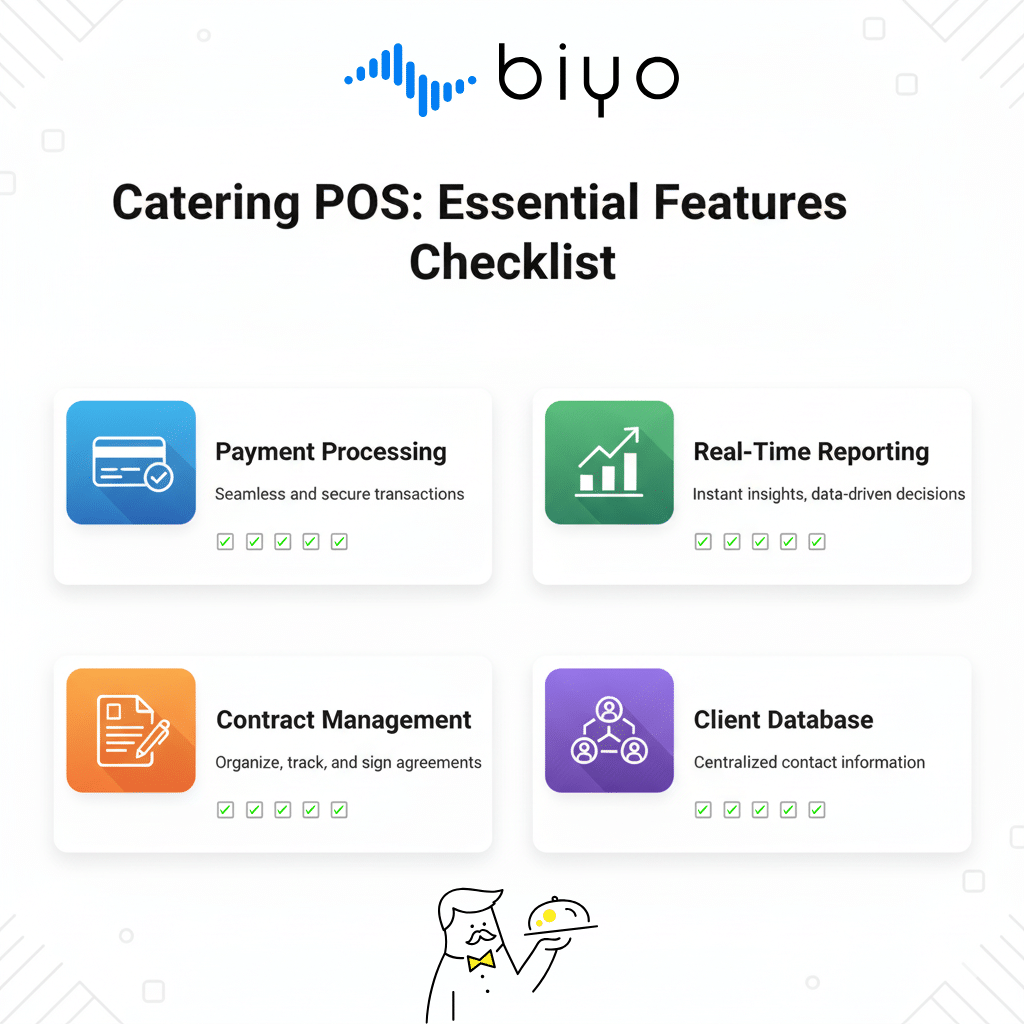
Why Choose Biyo POS for Catering?
If you’re ready to experience the benefits of a catering POS system, Biyo POS offers a tailored solution designed for catering businesses. With features like streamlined ordering, real-time reporting, and billing automation, Biyo POS empowers caterers to deliver outstanding service. You can schedule a call to see how Biyo POS can transform your operations, or head directly to the signup page to get started today.
FAQ
What is a catering POS system?
A catering POS system is software that manages all aspects of catering operations, including ordering, payment processing, staff scheduling, and reporting. It simplifies operations and improves efficiency.
How does a catering POS system help with event scheduling?
The system integrates calendars, staff assignments, and client requirements to ensure all aspects of an event align. This reduces errors and ensures smooth execution.
Can a catering POS system improve customer satisfaction?
Yes, by ensuring accurate orders, timely communication, and efficient service, the system enhances client satisfaction. Happy clients are more likely to book again and recommend the service to others.
Does a catering POS system help reduce costs?
Absolutely. By improving staff scheduling, inventory management, and expense tracking, the system reduces waste and unnecessary expenses. This increases profitability.
Is Biyo POS suitable for small catering businesses?
Yes, Biyo POS scales with your business. Whether you run small private events or large corporate functions, it offers tools to simplify management and support growth.
